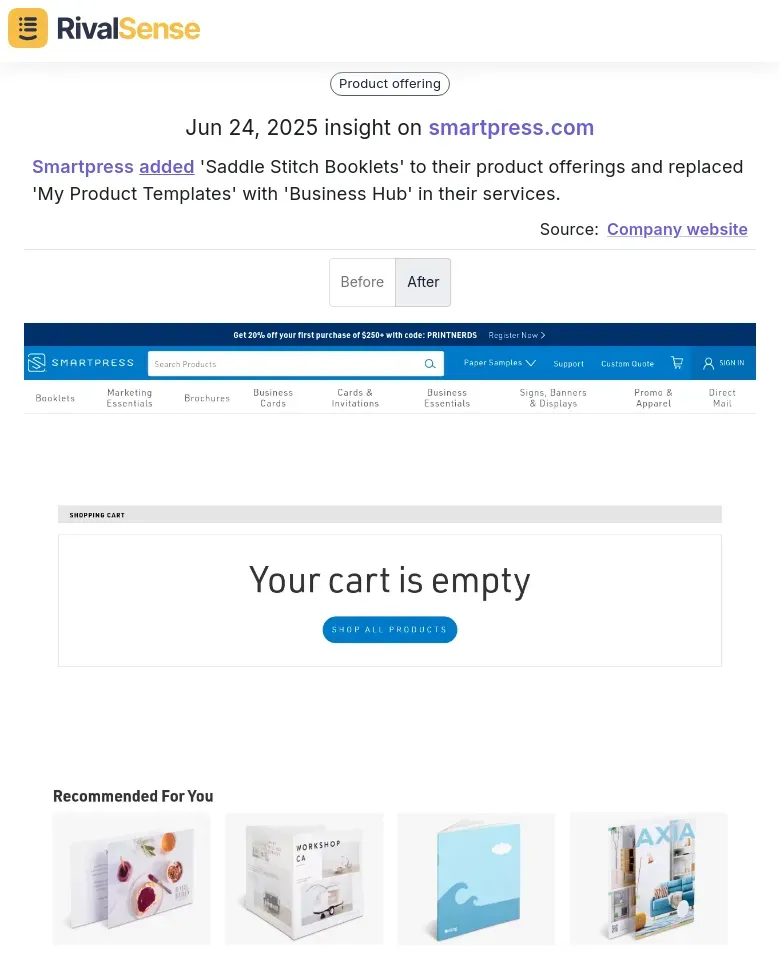How Smartpress's Product Shift Spurred Competitor Innovation
Before Smartpress's pivotal product shift, the market was dominated by a few key players, each with a stronghold on specific segments. Companies like PrintMaster and DocuTech led with traditional printing solutions, while Smartpress initially positioned itself as a mid-tier player, offering reliable but not groundbreaking services. The competitive landscape was static, with little innovation beyond incremental improvements. Smartpress struggled to differentiate in a crowded market where competitors targeted niches like enterprise contracts or educational materials.
Declining customer loyalty and digital disruption created urgent challenges, but also revealed opportunities in untapped areas like eco-friendly printing. This pressure forced Smartpress to rethink its approach and seek transformative change.
Practical Advice for Market Analysis:
🔍 Conduct thorough gap analysis to identify unmet needs
📊 Benchmark competitor strengths/weaknesses quarterly
💬 Host customer workshops to uncover pain points
🌐 Monitor emerging trends through industry reports
🎯 Craft a unique value proposition addressing market gaps
The Catalyst: Smartpress's Bold Product Shift
Smartpress's strategic pivot from traditional print services to a digital platform marked an industry turning point. Driven by goals to enhance customer experience through AI tools and real-time tracking, they aimed to increase market share and set new standards. The market response was polarized—customers welcomed the innovation while competitors scrambled to react.
Real-World Example: Tracking Strategic Product Evolution
Monitoring competitor product changes provides critical intelligence for anticipating market shifts. For instance, RivalSense captured how Smartpress added 'Saddle Stitch Booklets' while replacing 'My Product Templates' with 'Business Hub':

Why this matters: Such insights reveal strategic pivots (e.g., toward integrated solutions) before public announcements, allowing businesses to:
✅ Anticipate market demand shifts
✅ Identify service gaps in their offerings
✅ Accelerate responsive innovation
Actionable Steps for Product Shifts:
- 📋 Assess market readiness through pilot testing
- 🎯 Define success metrics (e.g., 30% retention increase)
- 👁️ Track competitor reactions via tools like RivalSense
- 📢 Communicate changes transparently to stakeholders
- 🔄 Iterate based on launch performance data
Competitor Reactions: Innovation as a Response
Smartpress's move triggered rapid innovation across the industry. Competitors like Printivo launched AI design tools within months, while Canva enhanced collaboration features—direct responses to Smartpress's automation focus. This innovation wave elevated customer expectations, forcing slower players to adapt or decline.
Timing proved critical: major competitive updates emerged within six months, demonstrating how quickly markets evolve post-disruption. Businesses must treat competitor moves as innovation catalysts rather than threats.
Checklist for Competitive Response:
- 🔔 Set alerts for competitor announcements
- 🕵️♂️ Identify weaknesses in their new offerings
- ⚡ Prototype response features in <60 days
- 📝 Validate concepts through customer feedback loops
Market Impact: Shifts in Consumer Preferences and Industry Standards
Smartpress's shift permanently altered industry dynamics. Consumers began expecting AI-driven automation and real-time workflows as standard features, not premium add-ons. Competitors accelerated R&D investments, transforming previous differentiators into baseline requirements.
Long-term effects included market consolidation around agile players and higher innovation velocity. Brands that adapted quickly gained disproportionate advantages through first-mover benefits.
Actionable Adaptation Framework:
| Step | Action | Outcome |
|---|---|---|
| 1 | Monitor competitor updates via RivalSense | Early trend detection |
| 2 | Quarterly customer preference surveys | Validated innovation priorities |
| 3 | Allocate 15% revenue to R&D | Sustainable innovation pipeline |
| 4 | Reposition messaging around new standards | Competitive differentiation |
Lessons Learned: Key Takeaways for Businesses
The Smartpress case underscores how agility and competitor intelligence drive market leadership. It demonstrates that waiting for industry shifts leaves businesses vulnerable to disruption. Proactive monitoring transforms competitive threats into strategic opportunities.
Essential Practices:
- 🧪 Foster innovation culture: Implement "innovation sprints" where teams prototype solutions quarterly
- 📡 Monitor competitors proactively: Use automated tools like RivalSense for real-time alerts on:
- Product launches
- Pricing changes
- Partnership announcements
- 🔮 Anticipate market shifts: Combine customer feedback with competitor trend analysis
- ⚡ Develop rapid-response protocols: Establish cross-functional SWAT teams for strategic pivots
- 📊 Conduct bi-monthly SWOT analyses: Turn insights into action plans
Conclusion: The Future of Competitive Strategy
Smartpress's transformation proves that bold innovation creates industry-wide ripple effects. As markets evolve faster, competitive intelligence becomes non-negotiable—it's the difference between leading change and scrambling to survive.
Future-Proof Your Strategy:
- Leverage automated tools like RivalSense for real-time competitor tracking
- Build organizational agility through quarterly strategy reviews
- Treat customer feedback as your innovation compass
Ready to decode competitor moves?
👉 Try RivalSense Free and get your first competitor report today—transform market shifts into growth opportunities.
📚 Read more
👉 Quick Instagram Hacks for Competitor Earnings Insights
👉 Best Practices in Competitive Intelligence for Wood-Based Panel Leaders
👉 5 Actionable Competitive Intelligence Insights for Product Strategy
👉 Decoding Noom's Muscle Defense™ Launch: Turning Competitor Insights into Action
👉 How to Track Competitor Funding and Growth: A Strategic Guide
